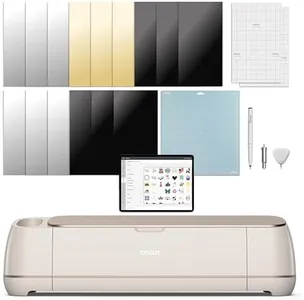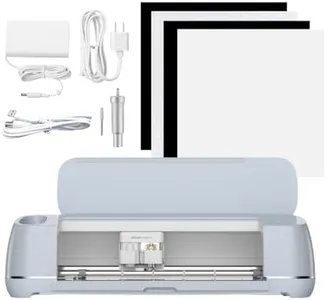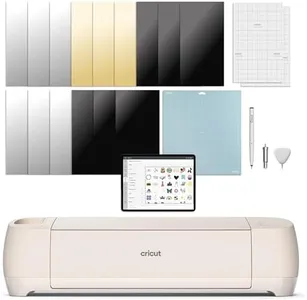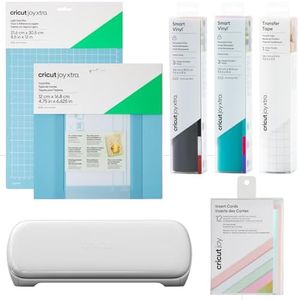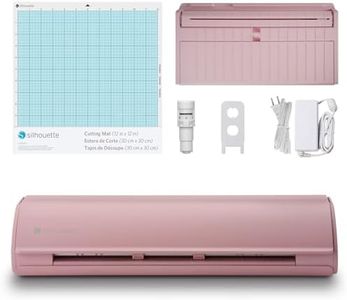We Use CookiesWe use cookies to enhance the security, performance,
functionality and for analytical and promotional activities. By continuing to browse this site you
are agreeing to our privacy policy
6 Best Cricut Machines
From leading brands and best sellers available on the web.Buying Guide for the Best Cricut Machines
Cricut machines are electronic cutting tools that make crafting easier and more professional, allowing you to cut materials like paper, vinyl, fabric, and more into precise shapes and designs. When buying a Cricut machine, it's important to match the machine's capabilities and features to your crafting goals. Consider things like what materials you want to use, the complexity of your typical projects, and the amount of space you have for your machine. Understanding the key specifications will help make sure you choose a machine that fits how you like to craft, so your experience is smooth and enjoyable.Cutting SizeCutting size, sometimes called cutting area or cutting width, is the largest size of material that the machine can cut in a single pass. This matters because it limits the maximum size of your projects, like decals, cards, stencils, or T-shirt designs. Generally, cutting sizes fall into small (around 6 inches), medium (about 12 inches), and large (up to 24 inches or more). If you mainly make small cards or labels, a smaller cutting size is enough. If you want to make bigger crafts like wall decals or large posters, look for a larger cutting size. Your typical craft size should guide your choice here.
Material CompatibilityMaterial compatibility is about which types of materials the machine can cut, such as paper, vinyl, fabric, leather, cardstock, or wood. Some machines are designed mainly for thin materials, while others can handle thicker or tougher items. If you only plan to cut paper or vinyl, most machines will work for you. However, if you want to work with fabrics, felt, leather, or balsa wood, look for machines that mention support for these. Let your intended projects and material creativity drive your decision.
Cutting Force/PressureCutting force, sometimes called pressure, is how hard the blade pushes down on the material. Higher cutting force allows the machine to cut through tougher or thicker materials more easily. Machines are often grouped as light force (good for paper and thin vinyl), medium force (can handle thicker cardstock and some fabrics), and high force (suitable for leather, chipboard, and some woods). If you plan to experiment with tougher materials, look for a higher force rating. For simple paper crafts, lower force is sufficient.
ConnectivityConnectivity refers to how you connect your Cricut machine to your computer, tablet, or phone. Common options are USB cables and wireless (Bluetooth). Some older or simpler machines may only have USB, while newer ones offer both. Wireless is more convenient for most people since you can place the machine anywhere in your craft space. If you want freedom to move your machine or use a mobile device, wireless is a must. If you’re always at a desk with a computer, USB will do.
Tools and Attachments SupportedDifferent Cricut machines support different types of tools, such as cutting blades, pens for drawing, scoring wheels, or rotary blades for fabric. Some machines can only fit basic blades and pens while others work with a wider range of tools for more creative options. Group machines by basic (cutting and drawing pens) and advanced (cutting, drawing, scoring, engraving, debossing, etc.). Think about your projects: if you know you’ll want to write, score, or cut specialty materials, pick a machine with the right tool compatibility.
Ease of Use and SoftwareHow easy the machine is to use depends both on its physical design and the software that controls it. Some machines are very beginner-friendly and have simple controls and easy-to-understand software, while others have more options and features that might need extra time to learn. If you prefer a simple, straightforward design, look for machines described as beginner-friendly. If you like experimenting with lots of custom settings, a more advanced model and software may suit you. Consider your comfort with technology to guide your pick.
Physical Size and PortabilityPhysical size means how big the machine is and whether it fits comfortably in your crafting space. Some are compact and lightweight, so they're easy to move and store, while others are larger and meant to stay in one place. Think about your crafting area and whether you’ll want to move the machine around. For smaller spaces or taking your machine to classes, a compact model is best. If you have a dedicated craft room, size may not matter as much.
